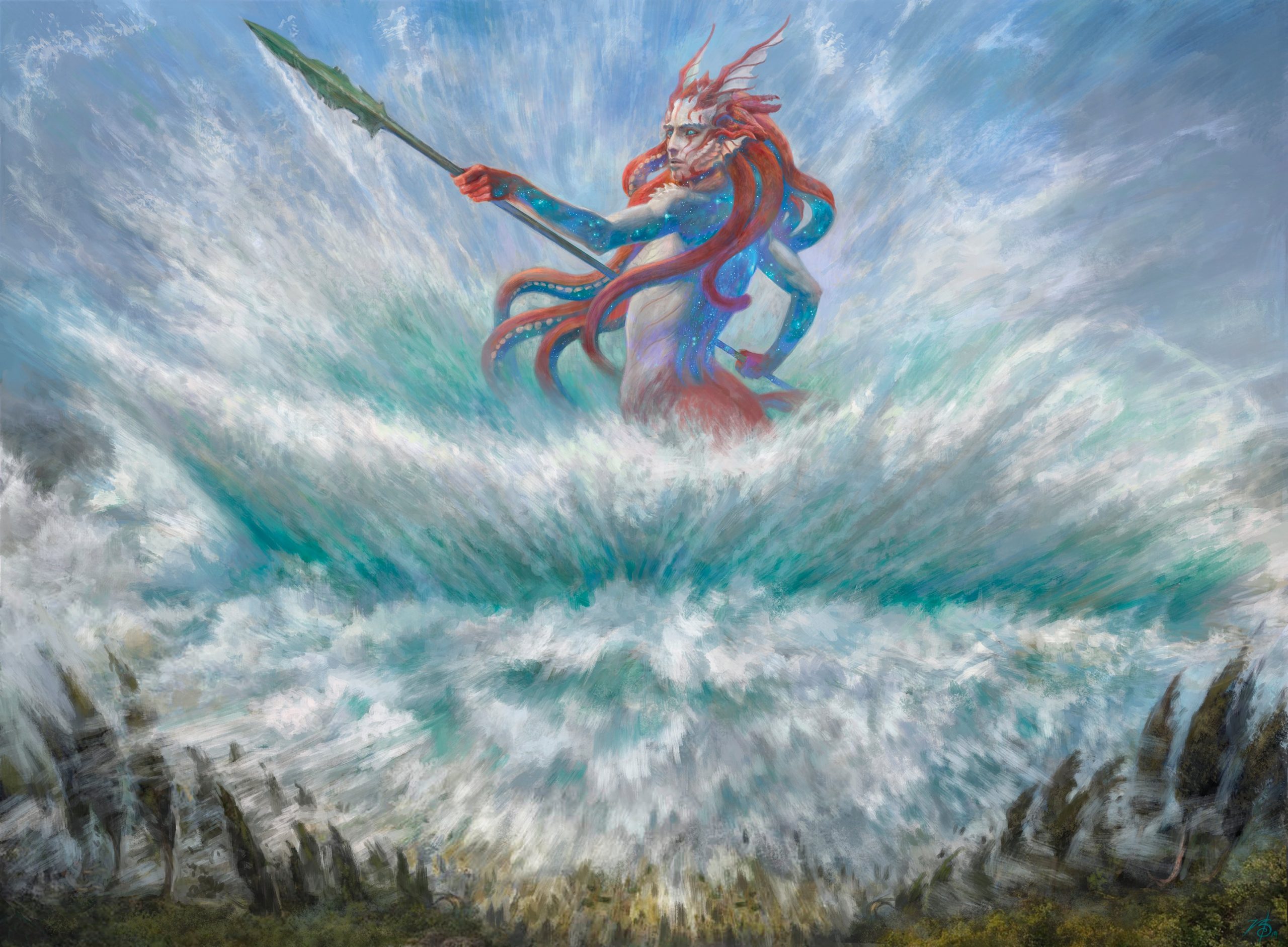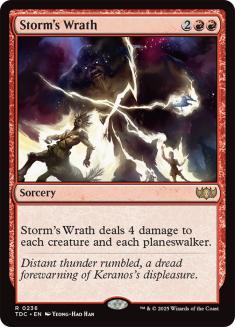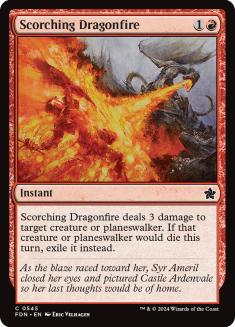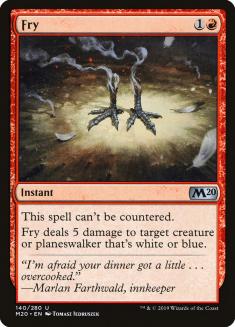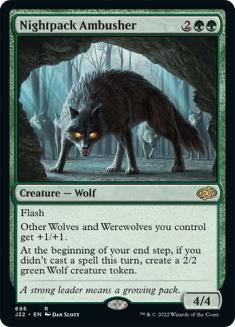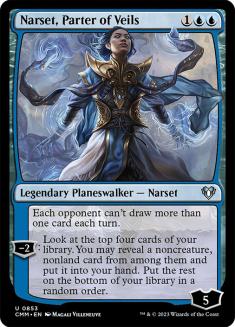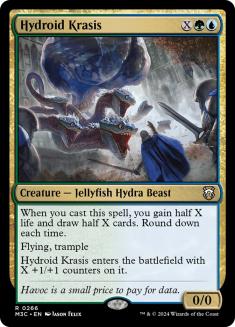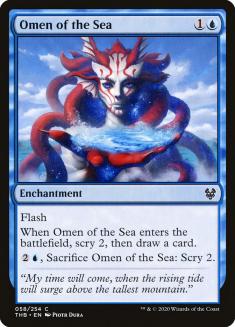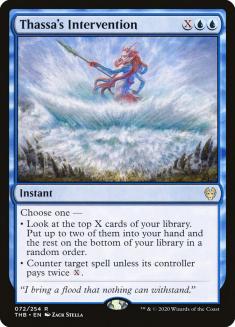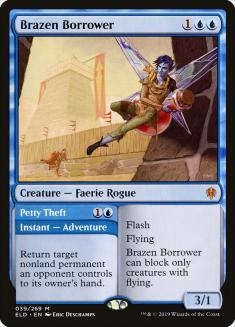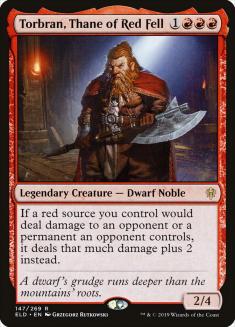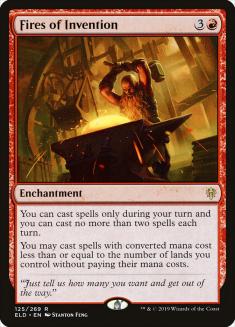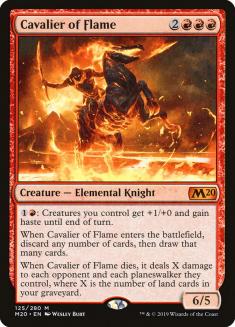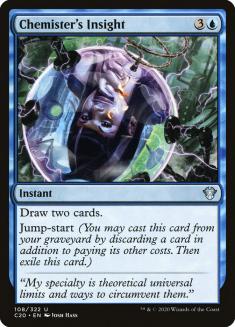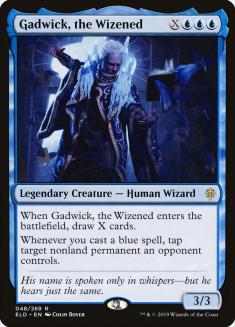This last weekend I played Temur Reclamation at World Championship XXVI, and managed to break through to the Top 8 double-elimination bracket with it. Suffice it to say I am a big fan of Temur Reclamation, hence choosing to bring it to such an important event, and whilst I could see myself bringing any of Temur Reclamation, Azorius Control, or Mono-Red Aggro to an event on any given weekend depending on how the metagame is shaping up, I am the most confident with Temur Reclamation and consider it to have the highest raw power level of all of these choices.
Creatures (9)
Lands (27)
Spells (24)
- 2 Opt
- 4 Expansion
- 4 Growth Spiral
- 4 Wilderness Reclamation
- 1 Scorching Dragonfire
- 2 Omen of the Sea
- 3 Storm's Wrath
- 4 Thassa's Intervention
Sideboard

This is the list I played at World Championship XXVI. Whilst there are a few details I’m looking to work on and some tech choices I want to try out, the fact that I registered this for such an important tournament shows that I’m already happy to endorse it in its current state. As such, this is the list I will be using to demonstrate sideboarding, though a lot of the advice I’m going to give regarding matchups is intentionally generalized enough such that it should apply well even if you swap a few cards around in the list.
Temur Reclamation is an unusual deck. It gets labelled as a combo deck a lot, and it is, but I think only referring to it as a combo deck is very reductive. A lot of the time it is every bit as much control as it is combo, seeking to interact with its opponent and keep their threats in check; it just happens that Expansion // Explosion is a much more final and, well, explosive win condition for a control deck to have than something like Dream Trawler.
I think the misconception that Temur Reclamation is purely a combo deck comes from Throne of Eldraine Standard when that’s largely what it was, but Uro, Titan of Nature’s Wrath and Storm’s Wrath have both changed things dramatically. It used to be you only had a finite amount of life to play with, and a finite ability to clear up the battlefield, which meant against any creature deck there would come a point where you had something like a two-turn window to close out the game before you would just die. The lifegain from Uro, and the manner in which Storm’s Wrath is much more effective at keeping the battlefield in check than Flame Sweep was, both make it much easier to just keep extending the game and this means there is a lot less pressure to cross your fingers and hope you can end the game immediately with a big Explosion.
Understanding that Temur Reclamation is now at its heart a control deck is an important part of learning to play it well and understanding your role in matchups. In particular this defines the nature of the Jeskai Fires matchup. Similarly being able to recognise when to shift between acting like a control deck and acting like a combo deck, and when to throw a spanner in the works by taking advantage of the flash-based tempo aspect of the deck offered by Brazen Borrower and Nightpack Ambusher, is key to knowing how to keep your opponents on edge, and to making their cards look as ineffective as you possibly can.
VS Azorius Control
Out:
In:
Generally I think Temur Reclamation is behind in Game 1 of this matchup as I currently have it configured, though how far you are behind depends a lot on the exact build of your opponent’s maindeck. The list that Paulo Vitor Damo da Rosa won World Championship XXVI with is about as hateful as they come with multiple maindeck Mystical Disputes as well as a third Dovin’s Veto and very little in the way of expensive clunky win conditions. That said, the more Azorius Control players are forced to respect aggressive matchups in a more open metagame, the better things will be for you.
Your most important priority early on is attempting to develop your mana, hitting every land drop you can, whilst making sure to keep your opponent’s three-mana planeswalkers off the battlefield. This makes these Game 1s quite a bit easier when you’re on the play as Thassa’s Intervention can actually stop Teferi, Time Raveler and Narset, Parter of Veils from resolving.
In general your deck is strategically advantaged against Azorius Control with the exception of these three-mana planeswalkers which significantly restrict your deck’s ability to function. Teferi turns off the ability of Wilderness Reclamation to do anything other than fuel scrying from Castle Vantress and Omen of the Sea, whilst Narset makes it incredibly hard to meaningfully out-card-advantage your opponent. There comes a point, once the game has developed, where Thassa’s Intervention becomes too hard to meaningfully hold open any more and at that point feel free to cash it in on your opponent’s end step as a fancy Divination; conveniently this moment often lines up with when you’re about to start missing land drops.
Your deck is very poorly set up to jam Wilderness Reclamation early in Game 1. It’s hard to resolve through your opponent’s countermagic, hard to defend with how little countermagic you have access to, and easily punished whether it resolves (and your opponent resolves Elspeth Conquers Death) or doesn’t (and you opponent resolves a three-mana planeswalker whilst you’re tapped low). Tend towards holding them for the late-game, either to attempt to punish your opponent for tapping low, or until such a point as getting it exiled with Elspeth Conquers Death isn’t a scary prospect.
Run out your Brazen Borrowers aggressively. The only time you’ll ever want more than one on the battlefield is if there is a Teferi on the stack and it has to die quickly, as over-committing into a Shatter the Sky is quite bad, but having just the one Borrower to generate some early damage will force your opponent to act in order to stem the bleeding, and will soften them up so that you can maybe even Explode your opponent out despite them having a Teferi on the battlefield.
If you ever manage to make your opponent tap out on their turn, and they don’t have a Narset, I am very into main-phasing a large Explosion or Hydroid Krasis on your turn whilst they can’t interact with you. Drawing three or four cards will help pull you meaningfully ahead, and hopefully dig you towards a Petty Theft or a red removal spell to undo any damage caused on your opponent’s turn once they untap. Part of the motivation for playing Hydroid Krasis instead of Gadwick, the Wizened is due to its resiliency against countermagic and its inability to get exiled by Elspeth Conquers Death, and both these traits shine in this matchup.
As will be the case in most matchups with this deck, in the sideboarded games things change substantially. You get to significantly upgrade your red removal spells into two copies of Fry, and get access to cheap countermagic of your own, all of which dramatically reduces the chance of an early planeswalker sticking on your opponent’s side.
Between this, and having access to Nightpack Ambusher, it is much easier to lean into the proactive role that the matchup forces you to take. A lot of Game 1s enter this holding pattern where you and your opponent are just staring at each other for a while whilst you try to pick your spot to go for it, whereas after sideboarding Mystical Dispute and Negate make it much easier to jam threats and hope you can push them through, and the combination of these cards and having Fry in the mix too means that if your threat doesn’t resolve you are well insulated from any threats your opponent then deploys in an effort to punish you.
VS Temur Reclamation
Out:
In:
Once you get used to the tempo of how the games play out, the Temur Reclamation mirror is fun. In Game 1 you have just enough interaction to threaten slowing your opponent down a turn or two, but rarely enough to actually outright stop them long-term. This means the games are a race to combo, whilst trying to choose the right spots with your interaction to trip your opponent up.
Sometimes your draws will consist of very little in the way of combo pieces, and instead a bunch of Brazen Borrowers and counterspells. In this case I think it’s fine to aggressively run out a Borrower and have that be your game plan. That said, with so little countermagic in your deck before sideboarding it is hard to keep your opponent from comboing for very long, so in more normalized draws I tend to value the Petty Theft half of Borrower more highly than the creature half for its ability to bounce a Wilderness Reclamation and in doing so often set your opponent back a turn; this makes me pretty keen on holding my Borrowers in hand Game 1 in all but exceptional circumstances.
If you have both Wilderness Reclamation and a piece of interaction for an opposing Reclamation in hand I lean towards just jamming my Reclamation onto the stack in Game 1. This is all situational of course; a particularly interaction-dense hand that also has a lot of land drops coming its way is less forced into this play pattern. That said, in order for your opponent to actually punish you casting your Reclamation, they need both a Petty Theft or counterspell, and then in addition a follow-up Reclamation of their own. If they don’t have a blue interactive spell, which they have a limited number of, then you propel very far ahead, and if they do have interaction but don’t have a Reclamation, then you’re still at a kind of parity except you’re now one step closer to whittling through their interaction.
If I have the choice of casting my Wilderness Reclamation into a potential counterspell or passing the turn but without interaction up, I lean much more aggressively towards just jamming. Again your opponent needs to have both a blue interactive spell and then a follow-up Reclamation of their own to punish you for this, except if their hand actually looks like that you probably lose the game by just passing the turn without attempting to cast a Reclamation of your own anyways because, as we just laid out, your opponent is incentivized to try and resolve their own Reclamation into your open mana in Game 1.
Things change a lot in the sideboarded games, which are practically flipped on their head. Because of the much higher density of interaction in the sideboarded games, with Negate, Aether Gust, and Mystical Dispute all joining the fray, it is much less easy to justify jamming a Wilderness Reclamation into open mana as it is so much more likely your opponent has the appropriate tools to punish you for this line. In Game 1, you lean slightly more towards recklessness, but post-sideboard you lean quite a bit towards being very cautious and trying to choose your spots.
With it being so much harder to tap out, this means that games go quite a bit longer and suddenly flash threats become much more threatening. I cast my Brazen Borrower in my opponent’s end step as soon as possible basically always in these sideboarded games, as now the card will get in for meaningful amounts of damage before forcing your opponent to act first into your grip of counterspells. This is a big part of why I like Nightpack Ambusher so much in the matchup too, as I just want as many ways as possible to act on my opponent’s end step and force them to start main-phasing spells first.
Along similar lines, the further behind you fall, the more you should lean towards making a move rather than waiting and being cautious. Eventually you reach a point where you have to hope your opponent doesn’t have the interaction they need to stop you, and that if they do then you can push through it across a couple-turn window. Having Mystical Dispute or Aether Gust in hand encourages me to be more aggressive with finally making a move with a Wilderness Reclamation as Dispute is very good at helping bash through opposing counterspells early and will get much worse at doing this if you wait to choose your spot, whilst Aether Gust makes it much harder for your opponent to punish you with their own Reclamation, as even if you don’t have the mana to hold Gust open, you can still deal with their enchantment once you untap.
VS Mono-Red Aggro
Out:
In:
Game 1 of this matchup is undeniably hard. I think post-sideboarding the games get substantially easier, enough so that the matchup is quite a bit closer than people think, but it’s easy to see why people assume Mono-Red Aggro must just crush Temur Reclamation based on these Game 1s.
With this in mind, if you know you’re against Mono-Red, mulligan aggressively in Game 1. I don’t tend to mulligan much with Temur Reclamation in general as hitting your land drops is so important that land-heavy hands are often better than they look as a result, whilst the amount of card draw and Temples in the deck means land-light hands will often get there, but this is definitely the place to send back unexciting hands.
In general in Game 1 I’m looking for one of two things. First is access to a Turn 3 Wilderness Reclamation via Growth Spiral, ideally then either with a clear route to a large Explosion or a fast Uro. Alternatively, Turn 4 Storm’s Wrath can do a lot of work, especially if you have a way to keep Anax, Hardened in the Forge off the battlefield either by bouncing it in your opponent’s end step with Petty Theft, or if you’re on the play countering it with Thassa’s Intervention.
Keeping Anax off the battlefield for your Storm’s Wrath turn is crucial because the 1/1 Satyrs he makes as you sweep the battlefield will often just kill you, especially with Torbran, Thane of Red Fell as a follow-up. If you don’t have a way to remove Anax, sometimes the solution is to try and set up copying Storm’s Wrath with an Expansion; this is a lot of mana and often too slow, but when you can set it up it will sweep the battlefield twice, thus taking down any Satyrs that the first Storm’s Wrath leaves behind.
In the sideboarded games, things get substantially easier and I think Temur is firmly favoured in them. Mono-Red gains very little in the way of tools, whereas you gain access to a huge quantity of cheap removal whilst Nightpack Ambuser both acts as an incredible blocker and a great way to turn the corner.
Notably in Game 1 you have very little play against Embercleave, and it’s hard to have the game go long without resolving both Storm’s Wrath and Uro. After sideboarding it’s realistic to win games by casting a couple of cheap removal spells, getting a bulky blocker on the battlefield, and then just insulating yourself against Embercleave with a piece of instant-speed interaction. This sounds like a lot of things need to go right, but the texture of your deck with all these sideboard cards in makes it more the case of just casting the cards in your deck in anything resembling a reasonable distribution to accomplish this. Meanwhile your dream draws in the sideboarded games now just bury your opponent, instead of merely giving you a fighting chance.
VS Jeskai Fires
Out:
In:
Jeskai Fires is the combo-midrange to Temur Reclamation’s combo-control; remembering this will explain a lot of what goes on in the matchup both before and after sideboarding. In Game 1, both your answers and your opponent’s answers are pretty ill-equipped to deal with the combo elements of each other’s decks. Your opponent will have Teferi, Time Raveler and sometimes Brazen Borrower as their only meaningful interaction with your plan of landing an early Wilderness Reclamation and trying to Explode them out before they can kill you. Meanwhile your only real interaction with the Fires of Invention plus Cavalier of Flame “combo kills” is to counter it with Thassa’s Intervention. Your Brazen Borrowers and Storm’s Wraths are very good at keeping their fair game in check, but are most often not enough against a resolved Turn 4 Fires of Invention.
There are two problems with this situation from the Temur player’s perspective. One is that your opponent’s interaction always shuts down your interaction if they land it, with a resolved Teferi making Thassa’s Intervention feel embarrassing here; you’re really interested in the counterspell mode, whereas the card draw mode is too slow to be relevant in most games of this matchup. Meanwhile your interaction only shuts down theirs if you have it at the exact right moment; Thassa’s Intervention can counter Teferi but only if you’re on the play and only if you can afford to hold your mana open.
The other problem is that if both you and your opponent don’t interact with one another, their deck tends towards being faster than yours. In this scenario, a Turn 4 Fires of Invention can often kill on Turn 5 with a Cavalier of Flame at the ready, whereas you need a lot more to go right to Turn 5 people and realistically goldfish Turn 6 with your strong draws. If you both want to combo each other, they get better interaction Game 1 and they’re just faster at doing it too. That’s not to say you won’t combo them sometimes here, and you should be prepared to try and do so when the opportunity presents itself, but it’s hard for this to be your primary gameplan going in.
Instead what you’ll often have to do is hope to slow them down just enough such that Uro and Hyrdoid Krasis can help bridge you to your end-game of casting some big Explosions. Uro and Hydroid Krasis used to be the very first cards I sideboarded out, assuming I needed to try to play a disruptive flash game that wouldn’t allow me to tap out on my turn, but it turns out this is actually the exact opposite approach to what you want to do; Uro and Krasis are the two cards in your deck that can go toe-to-toe with your opponent’s threats, and even outmuscle them, all the while drawing a bunch of cards in the process.
The only ways Jeskai will tend to have in their maindeck to answer these threats is bouncing them with Teferi and Petty Theft, and sometimes you’ll die from this tempo loss, but most of the time this just results in their Teferi being low enough on loyalty that it now dies to Storm’s Wrath whilst you get to draw a bunch more cards and gain a bit more life from redeploying these threats. I really do think the gigantic body of Hydroid Krasis is so important to this matchup that it is now the primary reason why I have this card in my deck over something like Chemister’s Insight or Gadwick, the Wizened, and as long as Jeskai Fires is popular I would not move away from this card.
This sideboarding plan has led to a lot of success in the matchup for me. In the sideboarded games both you and your opponent will be much more able to disrupt each other’s combo plans, which is actually exactly what you want; like I said, when you’re both comboing you’re at a disadvantage, but Uro and Hyrdoid Krasis mean that when you’re both just playing fair Magic your deck will generally overpower theirs, just like you’d tend to expect a control deck to do to a midrange deck. Cast some ramp spells; develop your mana; try to keep Teferi, Fires of Invention, and Cavalier of Flame off the battlefield; use Storm’s Wrath to clear up all the smaller threats; and soon enough your late-game will take over.
On a slightly strange note, be prepared to cast a lot of fair-mode Explosions in these sideboarded games. You’d think with cutting a Wilderness Reclamation, and leaning away from the combo plan, that maybe Explosion might be more awkward after sideboarding has occurred. Instead the games are suitably slower that you’ll often just find yourself tapping six lands on your main phase to kill your opponent’s Robber of the Rich or Teferi, Time Raveler, and then a couple of turns later tapping nine lands to take down a Cavalier, and so on. It sounds silly that this ends up being so commonplace considering how starkly it contrasts with how Game 1 tends to go, but having better tools to slow down your opponent and your opponent leaning into cheaper more readily answered threats and a greater amount of interaction really does warp these games considerably at times.
Your Turn
I hope this guide leads to a lot of wins for you with Temur Reclamation, or even allows you to understand your Temur Reclamation matchup from the other side of the battlefield if you choose to wield a different deck. There are other decks in Theros Beyond Death Standard of course, but these four matchups really do seem like the most major ones after so many of the best players on the planet brought these decks to battle with this last weekend at World Championship XXVI, so understanding them is key to your success.

